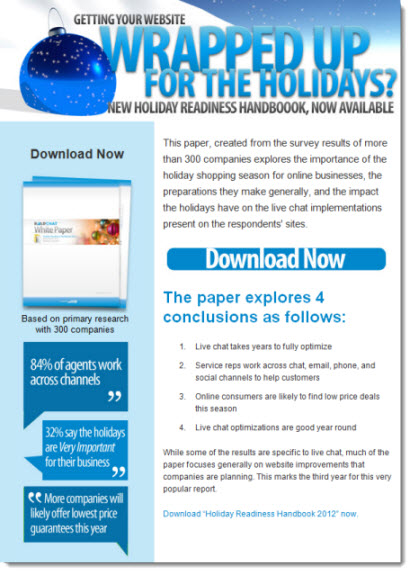If there’s one key element of demand generation copy that distinguishes it most from, let’s say: product collateral, or PR, or even social media, it’s this: a demand generation campaign is designed to drive action. In more basic terms, demand generation is about getting people to do stuff – namely, register for or download or request whatever it is you’re offering.
“How patently obvious,” you must be saying, but yet there are plenty of demand generation campaigns in market that, to all appearances, have forgotten that their stated purpose is to drive action.
Take the email below from LogMeIn, a company that markets live chat software as well as remote connectivity, collaboration, and support solutions. At first glance, there’s a lot to like about the campaign: an offer (survey report) that’s front and center in the design, and a call to action (“download now”) repeated multiple times throughout in both button and text form. The quotes in the sidebar, offering brief snippets of the report’s content, are a nice touch (though the excerpts themselves are none too exciting.)
 But then there’s the copy. If you remove the three instances where the email instructs the reader to “download now,” there is no other verbiage whatsoever that is designed to drive action.
But then there’s the copy. If you remove the three instances where the email instructs the reader to “download now,” there is no other verbiage whatsoever that is designed to drive action.
It’s as if (and this is my theory) someone took an abstract, the sort of 50-word description one might write for a content syndication program, pasted that copy into an email template, and pronounced it ready for broadcast.
The first paragraph (“This paper …”) is a reasonably compelling description of what sounds to be an informative report, but nothing that suggests what the reader might learn, or gain, or benefit from the insight it contains, nor any suggestion for how the reader might lay his/her hands on said insight.
Imagine if the same opening had been written with more action-oriented language:
“Download this exclusive survey report, drawn from the responses of more than 300 leading online marketers, and gain valuable insights on how to get the most from this year’s holiday shopping season. In just minutes, you’ll learn what steps you and your agents can take NOW to prepare for the most important time of the ecommerce year.”
Note also the sub-head: “The paper explores 4 conclusions as follows …” and ask yourself: “Why do I care?” and “What’s in it for me?” The bullets that follow read as a table of contents, where instead they should be compelling benefits tied directly to the desired action, as in:
“Download your copy of the report today, and you’ll learn:”
Remember: your campaign has one aim – getting people to respond. If your email copy seems stale, or reads too much like a brochure, liven it up with compelling, response-oriented language that drives the reader to act.
